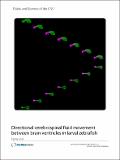| dc.contributor.author | Fame, Ryann M. | |
| dc.contributor.author | Hong, Alex | |
| dc.contributor.author | Aponte Santiago, Nicole Ann | |
| dc.contributor.author | Chang, Jessica T. | |
| dc.contributor.author | Sive, Hazel L. | |
| dc.date.accessioned | 2017-05-19T15:33:04Z | |
| dc.date.available | 2017-05-19T15:33:04Z | |
| dc.date.issued | 2016-06 | |
| dc.date.submitted | 2016-02 | |
| dc.identifier.issn | 2045-8118 | |
| dc.identifier.uri | http://hdl.handle.net/1721.1/109207 | |
| dc.description.abstract | Background
Cerebrospinal fluid (CSF) contained within the brain ventricles contacts neuroepithelial progenitor cells during brain development. Dynamic properties of CSF movement may limit locally produced factors to specific regions of the developing brain. However, there is no study of in vivo CSF dynamics between ventricles in the embryonic brain. We address CSF movement using the zebrafish larva, during the major period of developmental neurogenesis.
Methods
CSF movement was monitored at two stages of zebrafish development: early larva [pharyngula stage; 27–30 h post-fertilization (hpf)] and late larva (hatching period; 51–54 hpf) using photoactivatable Kaede protein to calculate average maximum CSF velocity between ventricles. Potential roles for heartbeat in early CSF movement were investigated using tnnt2a mutant fish (tnnt2a −/−) and chemical [2,3 butanedione monoxime (BDM)] treatment. Cilia motility was monitored at these stages using the Tg(βact:Arl13b–GFP) transgenic fish line.
Results
In wild-type early larva there is net CSF movement from the telencephalon to the combined diencephalic/mesencephalic superventricle. This movement directionality reverses at late larval stage. CSF moves directionally from diencephalic to rhombencephalic ventricles at both stages examined, with minimal movement from rhombencephalon to diencephalon. Directional movement is partially dependent on heartbeat, as indicated in assays of tnnt2a −/− fish and after BDM treatment. Brain cilia are immotile at the early larval stage.
Conclusion
These data demonstrate directional movement of the embryonic CSF in the zebrafish model during the major period of developmental neurogenesis. A key conclusion is that CSF moves preferentially from the diencephalic into the rhombencephalic ventricle. In addition, the direction of CSF movement between telencephalic and diencephalic ventricles reverses between the early and late larval stages. CSF movement is partially dependent on heartbeat. At early larval stage, the absence of motile cilia indicates that cilia likely do not direct CSF movement. These data suggest that CSF components may be compartmentalized and could contribute to specialization of the early brain. In addition, CSF movement may also provide directional mechanical signaling.
Keywords
Cerebrospinal fluid Brain ventricular system Fluid dynamics Zebrafish | en_US |
| dc.description.sponsorship | National Science Foundation (U.S.) (NSF IOS-1258087) | en_US |
| dc.language.iso | en_US | |
| dc.publisher | Biomed Central Ltd | en_US |
| dc.relation.isversionof | http://dx.doi.org/10.1186/s12987-016-0036-z | en_US |
| dc.rights | Creative Commons Attribution 4.0 International License | en_US |
| dc.rights.uri | http://creativecommons.org/licenses/by/4.0/ | en_US |
| dc.source | BMC | en_US |
| dc.title | Directional cerebrospinal fluid movement between brain ventricles in larval zebrafish | en_US |
| dc.type | Article | en_US |
| dc.identifier.citation | Fame, Ryann M.; Chang, Jessica T.; Hong, Alex; Aponte-Santiago, Nicole A. and Sive, Hazel. “Directional Cerebrospinal Fluid Movement Between Brain Ventricles in Larval Zebrafish.” Fluids and Barriers of the CNS 13, no. 11 (June 2016): p. 1-12 © 2016 The Author(s) | en_US |
| dc.contributor.department | Massachusetts Institute of Technology. Department of Biology | en_US |
| dc.contributor.mitauthor | Chang, Jessica Tzung-Min | |
| dc.contributor.mitauthor | Hong, Alex | |
| dc.contributor.mitauthor | Aponte Santiago, Nicole Ann | |
| dc.contributor.mitauthor | Sive, Hazel L | |
| dc.relation.journal | Fluids and Barriers of the CNS | en_US |
| dc.eprint.version | Final published version | en_US |
| dc.type.uri | http://purl.org/eprint/type/JournalArticle | en_US |
| eprint.status | http://purl.org/eprint/status/PeerReviewed | en_US |
| dspace.orderedauthors | Fame, Ryann M.; Chang, Jessica T.; Hong, Alex; Aponte-Santiago, Nicole A.; Sive, Hazel | en_US |
| dspace.embargo.terms | N | en_US |
| dc.identifier.orcid | https://orcid.org/0000-0001-9765-1376 | |
| dc.identifier.orcid | https://orcid.org/0000-0002-4890-424X | |
| mit.license | PUBLISHER_CC | en_US |
